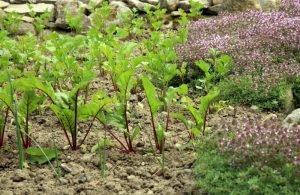Last Updated on July 28, 2025 by teamobn
If you are a gardener who values your leafy greens, you should consider growing a crop of colorful Swiss chard. For people on a vegan or keto diet, chard is the perfect companion to kale and spinach.
The vegetable – which comes in a surprising variety of colors – is a bit crunchier than spinach, but more tender than kale. The bright, veiny stems and the lush green leaves of the Swiss Chard make it one of the most striking plants in any garden.
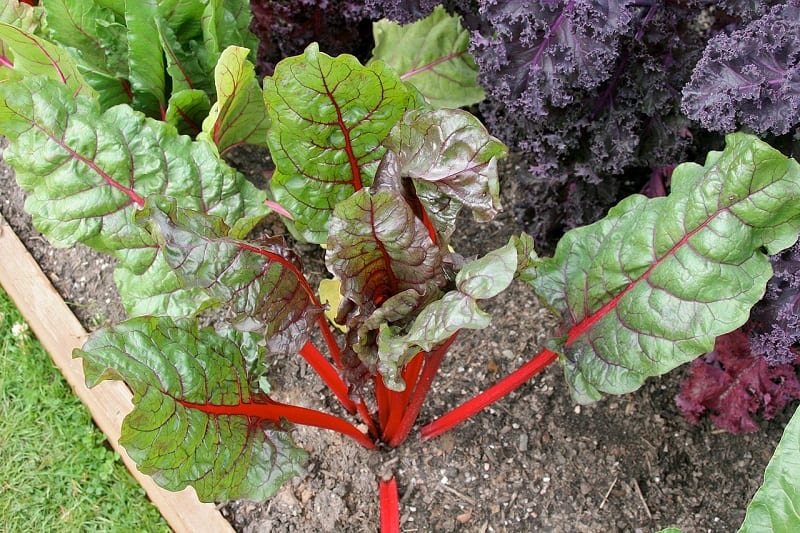
Growing Swiss chard in your backyard.
Contents
The Swiss chard – a member of the beet family – is remarkably nutritious. The vegetable is full of antioxidants and is packed with Vitamin A and Vitamin C. But because it does not ship well, it’s always best to grow the vegetable in your backyard.
While tolerant of high temperatures, Swiss chard is typically grown as a cool-season crop. That’s because it flourishes more easily in the chillier temperatures of spring and fall.

(Photo: David Fisher/Flickr)
Planting Swiss Chard
Growing Swiss chard is a smart choice for both new and experienced gardeners. This leafy green is easy to manage and offers a long harvest season with minimal effort.
Soil and Sunlight Conditions for Swiss Chard
To grow Swiss chard successfully, start by choosing a spot with full sun or partial shade. The soil must drain well and stay consistently moist. Mix in rich compost before planting to give your Swiss chard the nutrients it needs to establish quickly.
This boost in organic matter supports root development and encourages vibrant leafy growth. Avoid planting in compacted or dry soil as that can stress the plant and slow down germination. Healthy soil is the first step to a long-lasting chard harvest.
When and How to Plant Swiss Chard
Plant Swiss chard seeds about two to three weeks before your area’s last spring frost. This cool-season crop can handle light frost and will thrive in early spring conditions. To keep a steady supply, sow new seeds every 10 days for the next month.
Place seeds ½ to 1 inch deep and space them 2 to 4 inches apart in each row. Keep rows about 18 inches apart to give the plants room to mature without crowding. This layout also makes weeding and watering more manageable throughout the season.
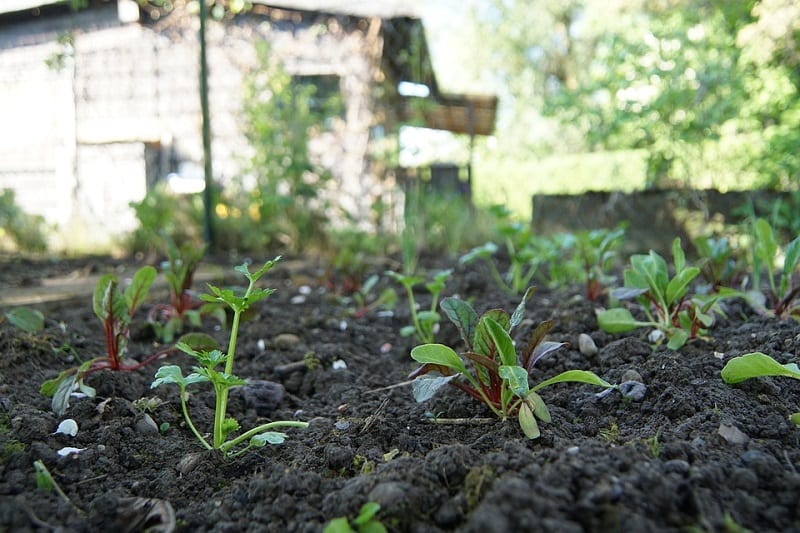
Caring for Your Crop
Proper care is essential to growing strong, flavorful Swiss chard throughout the season. A little attention each week can result in a steady supply of leafy greens for your kitchen.
Watering and Thinning for Healthy Growth
Swiss chard thrives when soil moisture stays consistent. Make it a habit to water your plants deeply and evenly, especially during dry periods. This crop needs around 1 to 1½ inches of water each week.
Don’t rely on quick surface sprinkling, aim for a slow, steady soak that reaches the roots. Once your chard seedlings are 3 to 4 inches tall, thin them out. Space each plant 6 to 8 inches apart so they can spread without competing for light and nutrients. Thinning might feel counterproductive, but it helps ensure your remaining plants grow fuller and stronger.
Mulching to Preserve Moisture and Control Weeds
Mulching is one of the easiest ways to improve your Swiss chard’s growing environment. Organic mulch like wheat straw, shredded leaves, or fine bark helps retain moisture by reducing evaporation from the soil. This is especially useful during warm weather when the sun can dry out unprotected beds quickly.
Mulch also insulates the soil, keeping the root zone cooler and more stable in temperature. Another benefit is weed suppression. A thick layer of mulch makes it harder for weeds to push through, saving you from constant weeding and protecting your chard from competition. Just keep mulch a few inches away from the plant base to avoid stem rot.
Supporting Continued Growth and Leaf Quality
Once your plants are established, regular care keeps them producing tender leaves. Remove any yellowing or damaged leaves as they appear. This encourages the plant to put its energy into new growth rather than trying to repair older leaves.
Fertilizing lightly every few weeks with a balanced organic fertilizer can also support steady production, especially if your soil isn’t very rich. Always water after applying any fertilizer to help distribute nutrients into the soil. Swiss chard is a cut-and-come-again crop, so you can start harvesting outer leaves as needed without disturbing the center of the plant. This method helps extend your harvest window and keeps the crop vigorous.
Watch for Pests and Act Early
Even hardy crops like Swiss chard can attract pests. Keep an eye out for leaf miners, aphids, and slugs. Leaf miners leave winding trails on leaves, while aphids cluster near the base or undersides. Handpick pests or use a blast of water to knock them off. Row covers can also protect your crop in its early stages.
Avoid using harsh chemicals, especially if you’re harvesting regularly. Healthy plants grown in compost-rich soil are usually more resistant, so prevention starts with good planting habits. Regular inspection and gentle intervention will keep your Swiss chard thriving all season long.
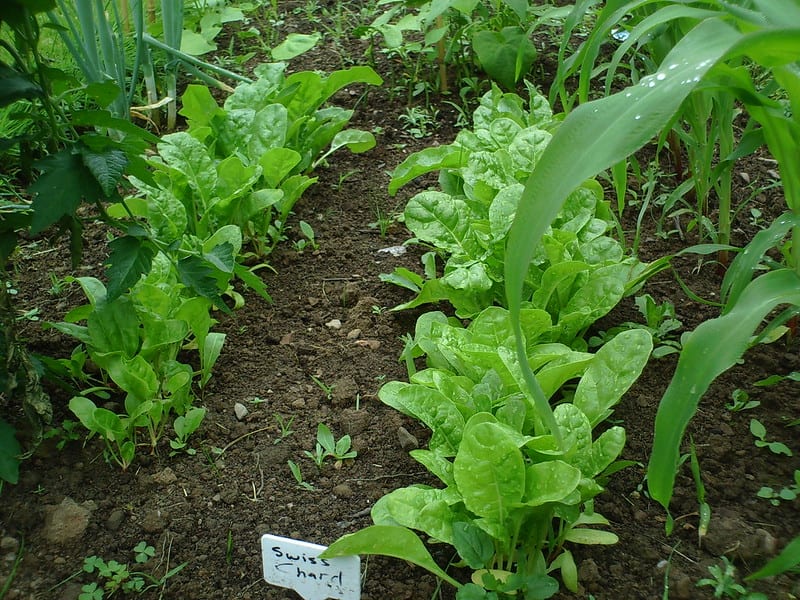
(Photo: Jesse Mann/Flickr)
Harvesting Swiss Chard
Harvesting Swiss chard at the right time ensures you get crisp, tender leaves packed with flavor. With the right technique, you can grow Swiss chard that keeps producing for months.
When and How to Harvest Swiss Chard
You can begin harvesting Swiss chard once the plants reach 6 to 8 inches in height. Use a sharp knife or garden scissors to cut the outer leaves about 1½ inches above the soil. Always leave the inner leaves intact so the plant continues growing. This method, known as “cut and come again,” allows the plant to regenerate.
By taking only the mature, outer leaves, you’re encouraging a steady flow of new growth. It’s one of the reasons so many gardeners choose to grow Swiss chard—because of its generous, repeated harvests.
Focus on Leaf Size and Timing
As the plant matures, watch for when it reaches about 12 inches tall. This is the sweet spot for cutting back more heavily without sacrificing quality. If you wait too long, the leaves can become tough and bitter. Swiss chard is most flavorful when picked young to mid-size.
If the plant becomes overgrown, it loses its tender texture and mild taste. So timing matters. Make harvesting a regular part of your routine if you grow Swiss chard for salads, sautés, or soups.
Tips for Prolonging Your Harvest
To get the most out of your crop, rotate your cuts. Don’t remove all the leaves from a single plant at once. Instead, take a few mature leaves from each plant across the row. This balanced approach helps avoid stressing any single plant and keeps your garden full of vibrant greens.
With care and attention, you can grow Swiss chard that delivers a continuous harvest throughout the season. If you’re in a warm climate, you might even get production into the cooler months with some light protection.
Store and Use Your Harvest Quickly
Once harvested, rinse the leaves gently and store them in the refrigerator. Use them within a few days for best flavor and texture. You can grow Swiss chard not just for its productivity, but also because it stores well and remains versatile in the kitchen. Whether you sauté it with garlic or mix it into stews, properly harvested Swiss chard brings fresh, earthy flavor to any dish.
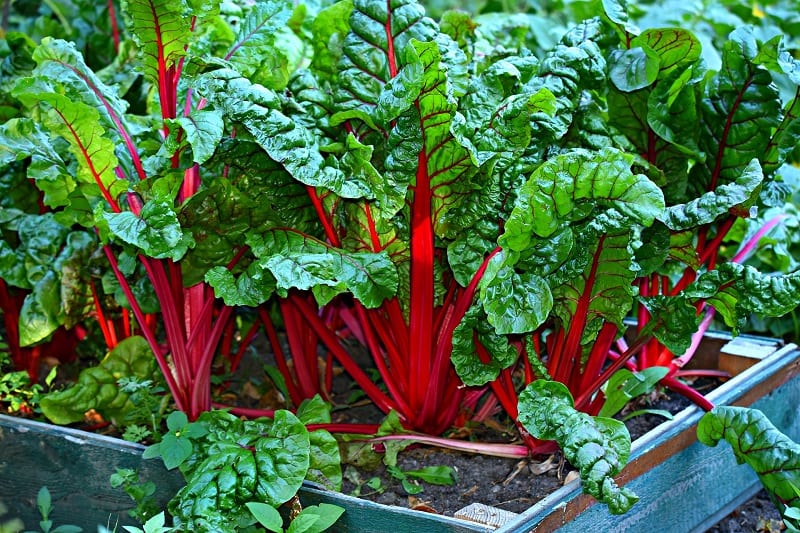
Brimming with Health Benefits
Swiss chard isn’t just a productive garden vegetable—it’s also packed with nutrients that support overall health. Its colorful stems and deep green leaves add both visual appeal and powerful benefits to your plate.
Nutritional Powerhouse for Everyday Meals
Swiss chard is a flexible ingredient that works well in many dishes. You can toss the fresh leaves into salads, blend them into smoothies, or sauté them as a side. They also hold up well in soups, casseroles, and stir-fries. If you’re trying to eat more greens, grow Swiss chard for its ability to deliver flavor without overpowering other ingredients.
The leaves are soft enough to eat raw, while the ribs—though tougher—can be chopped and cooked until tender. These stalks take well to roasting or braising and offer a satisfying crunch along with extra vitamins.
Loaded with Antioxidants and Disease-Fighting Compounds
One reason so many people grow Swiss chard is its antioxidant content. The vegetable contains a variety of beneficial compounds like quercetin, kaempferol, rutin, and vitexin. These flavonoids help the body fight inflammation, protect against oxidative stress, and may lower the risk of heart disease, diabetes, and certain cancers.
Diets high in antioxidants also support cellular repair and healthy aging. Eating Swiss chard regularly gives your body tools to counteract daily exposure to environmental toxins and stressors. Even a few servings a week can make a difference in supporting your immune system and overall well-being.
Rich in Vitamins and Minerals
In addition to antioxidants, Swiss chard provides impressive amounts of vitamins A, C, and K, along with magnesium, potassium, and iron. These nutrients play essential roles in immune function, blood clotting, bone health, and energy production.
One cup of cooked Swiss chard can supply more than 300% of your daily vitamin K needs. Growing Swiss chard at home gives you fresh access to these vital nutrients without relying on store-bought greens that may lose potency over time. Harvest it fresh and enjoy its health benefits at their peak.
Here’s a quick video…
Why Swiss Chard Belongs in Your Garden and Kitchen
If you’re looking to growing Swiss chard, you’re choosing more than just a leafy green. You’re investing in a plant that fuels your body and strengthens your meals with minimal effort. It’s a smart, flavorful, and nutrient-dense addition to any kitchen garden.




